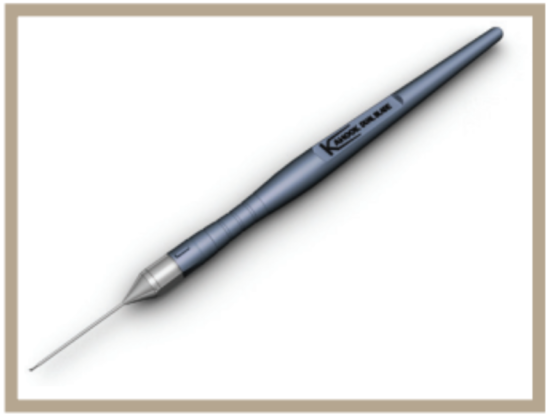The ideal MIGS device is safe and efficacious in a wide variety of patients, and also increases efficiency in the operating room. We may finally have it. The Kahook Dual Blade (KDB; New World Medical) removes part of the trabecular meshwork (TM) and the outer wall of Schlemm canal during a goniotomy, eliminating resistance to aqueous leaving the anterior chamber. The dual blade is a single use, stainless steel ophthalmic knife (Figure). A long, thin neck allows for easy insertion through a small clear corneal incision. A sharp point at the tip of the device allows for access to the Schlemm canal through the TM. A ramp then lifts and stretches tissue while two thin blades excise a strip of TM.

Image courtesy of New World Medical
FIGURE. Kahook Dual Blade.
The TM Approach
Conceptually, if the TM is addressed, the eye and outflow system can be rejuvenated. Opening the TM allows the canal and collector channels to get aqueous outflow once again, revitalizing the pathway system out of the eye. The TM approach is much more logical as it restores the natural outflow, according to Nathan Radcliffe, MD, who directs the Glaucoma Service at New York University and operates at New York Eye Surgery Center.
It is also possible to access many collector channels with the KDB. A stent, while exceptionally safe, is most likely only renewing aqueous flow to one or two collector channels near the stent. “A goniotomy with KDB approach may result in slightly more bleeding,” Dr. Radcliffe says. “However, it also results in a proportionate amount of extra pressure lowering.”
A Unique Instrument
This instrument removes the TM without destruction to the surrounding tissue unlike other processes or traditional goniotomy. Procedures that cause collateral damage can increase the risk of infection, inflammation, and scarring, all issues that are not of concern with this blade. Additionally, it removes enough of the TM that the canal remains open for an extended period of time, whereas with other procedures the TM may close again.
I. Paul Singh, MD, states, “The KDB is also very compact and intuitive. Other devices will open Schlemm’s canal, however, they may require additional paraphernalia in order to do so.” The blade works without the need for further equipment, and without leaving a foreign body in the eye, making it a huge advantage in the OR.
“The positive responder rate is also a unique feature from my perspective,” says Dr. Singh, an ophthalmologist at The Eye Centers of Racine & Kenosha in Wisconsin. Not every MIGS device will have the same efficacy for every patient, mostly because we cannot for certain determine preoperatively where the resistance resides. “What I like about the KDB,” adds Dr. Singh, “is that it works on multiple mechanisms. It both unroofs Schlemm canal and opens the TM. This has resulted in very high rates of successful results in my practice.”
This versatile dual blade can be used both in conjunction with cataract surgery or as a stand-alone procedure, which opens the patient pool tremendously. According to Blake Williamson, MD, the KDB can be performed on any patient on the spectrum, from mild to severe, from patients who are on one drop to patients who are on three drops with dense defects on the visual field. “As long as there is good visualization of the TM, this technique can be used for almost any patient. The conjunctiva is spared,” says Dr. Williamson, a comprehensive ophthalmologist and cataract surgeon at the Williamson Eye Center in Baton Rouge, Louisiana. “So, in my mind, unless there are contraindications to this procedure, or if the patient is extremely noncompliant, there are no downsides in at least trying an angle-based procedure.”
In phakic patients, “I prefer to use KDB with my more moderate to severe patients,” Dr. Williamson continues.
Those patients who may not be good candidates for the KDB include those who are already in need of more invasive procedures such as neovascular glaucoma patients; patients who have uveitic glaucoma; and in patients where the TM cannot be visualized well. Overall, the mechanism of action, the clean procedure, lack of surrounding tissue damage, and the wide variety of patients who can be helped, all combine to make this instrument a significantly advantageous and innovative device.
Drs. Radcliffe, Singh, and Williamson serve as consultants to New World Medical.


